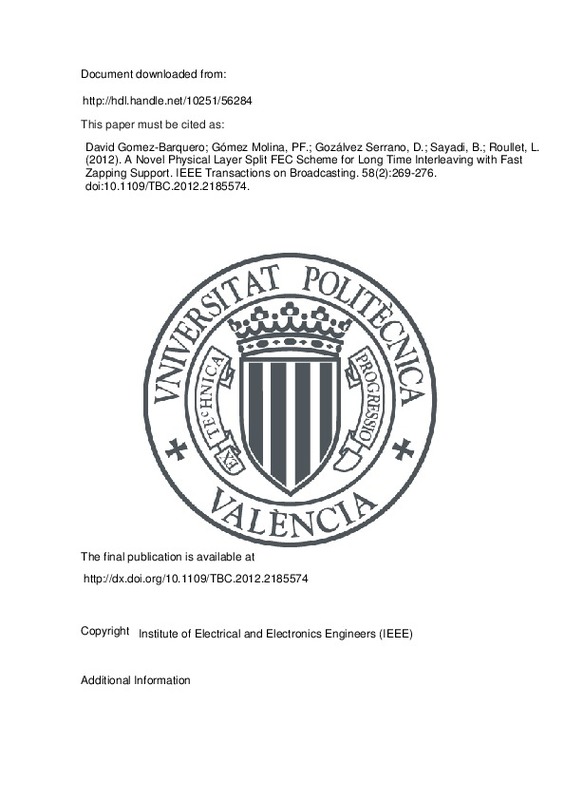JavaScript is disabled for your browser. Some features of this site may not work without it.
Buscar en RiuNet
Listar
Mi cuenta
Estadísticas
Ayuda RiuNet
Admin. UPV
A Novel Physical Layer Split FEC Scheme for Long Time Interleaving with Fast Zapping Support
Mostrar el registro sencillo del ítem
Ficheros en el ítem
| dc.contributor.author | Gómez Barquero, David
|
es_ES |
| dc.contributor.author | Gómez Molina, Pedro Fernando
|
es_ES |
| dc.contributor.author | Gozálvez Serrano, David
|
es_ES |
| dc.contributor.author | Sayadi, Bessem
|
es_ES |
| dc.contributor.author | Roullet, Laurent
|
es_ES |
| dc.date.accessioned | 2015-10-21T07:15:25Z | |
| dc.date.available | 2015-10-21T07:15:25Z | |
| dc.date.issued | 2012-06 | |
| dc.identifier.issn | 0018-9316 | |
| dc.identifier.uri | http://hdl.handle.net/10251/56284 | |
| dc.description.abstract | This paper describes a novel forward error correction (FEC) and time interleaving scheme, known as BB-iFEC (Base Band inter-burst FEC), aimed to provide long time interleaving with fast zapping support. BB-iFEC is a split FEC scheme with an outer FEC and an outer time interleaver concatenated to the inner FEC and inner time interleaver. It is based on the link layer FEC scheme of the hybrid satellite-terrestrial mobile broadcasting standard DVB-SH (Satellite to Handhelds), known as MPE-iFEC (Multi Protocol Encapsulation inter-burst FEC), but moved down to the physical layer. This allows full transparency towards upper layers, as well as reduced signaling overhead and packet fragmentation. However, the major novelty is that it allows re-using the soft information at the output of the inner FEC decoder (i.e., the log-likelihood ratios, LLRs). Compared to hard decoding, this improves the performance at the expense of higher memory requirements at the receivers. Nevertheless, BB-iFEC allows to efficiently perform either soft or hard decoding, being thus a scalable solution. Another important advantage is that it can be introduced in future evolutions of existing systems, because it allows allows co-existence of terminals with and without long time interleaving support. The paper describes the main features of BB-iFEC and its implementation at the transmitter and receiver side. The paper also presents illustrative results for future evolutions of the digital terrestrial TV standard DVB-T2 (Second Generation Terrestrial), such as the next generation mobile broadcasting technology DVB-NGH (Next Generation Handheld). | es_ES |
| dc.language | Inglés | es_ES |
| dc.publisher | Institute of Electrical and Electronics Engineers (IEEE) | es_ES |
| dc.relation.ispartof | IEEE Transactions on Broadcasting | es_ES |
| dc.rights | Reserva de todos los derechos | es_ES |
| dc.subject | DVB-NGH | es_ES |
| dc.subject | Fast zapping | es_ES |
| dc.subject | FEC | es_ES |
| dc.subject | Movile TV | es_ES |
| dc.subject | Time interleaving | es_ES |
| dc.subject.classification | TEORIA DE LA SEÑAL Y COMUNICACIONES | es_ES |
| dc.title | A Novel Physical Layer Split FEC Scheme for Long Time Interleaving with Fast Zapping Support | es_ES |
| dc.type | Artículo | es_ES |
| dc.identifier.doi | 10.1109/TBC.2012.2185574 | |
| dc.rights.accessRights | Abierto | es_ES |
| dc.contributor.affiliation | Universitat Politècnica de València. Instituto Universitario de Telecomunicación y Aplicaciones Multimedia - Institut Universitari de Telecomunicacions i Aplicacions Multimèdia | es_ES |
| dc.description.bibliographicCitation | Gómez Barquero, D.; Gómez Molina, PF.; Gozálvez Serrano, D.; Sayadi, B.; Roullet, L. (2012). A Novel Physical Layer Split FEC Scheme for Long Time Interleaving with Fast Zapping Support. IEEE Transactions on Broadcasting. 58(2):269-276. doi:10.1109/TBC.2012.2185574 | es_ES |
| dc.description.accrualMethod | S | es_ES |
| dc.relation.publisherversion | http://dx.doi.org/10.1109/TBC.2012.2185574 | es_ES |
| dc.description.upvformatpinicio | 269 | es_ES |
| dc.description.upvformatpfin | 276 | es_ES |
| dc.type.version | info:eu-repo/semantics/publishedVersion | es_ES |
| dc.description.volume | 58 | es_ES |
| dc.description.issue | 2 | es_ES |
| dc.relation.senia | 236619 | es_ES |







![[Cerrado]](/themes/UPV/images/candado.png)

